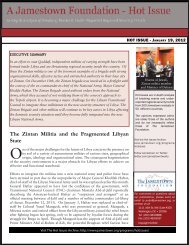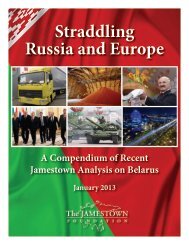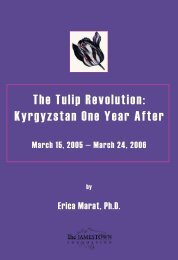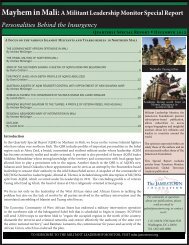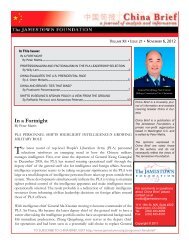By Brian Glyn Williams - The Jamestown Foundation
By Brian Glyn Williams - The Jamestown Foundation
By Brian Glyn Williams - The Jamestown Foundation
You also want an ePaper? Increase the reach of your titles
YUMPU automatically turns print PDFs into web optimized ePapers that Google loves.
AFTERWORD<br />
It was on these four battlefronts that the Crimean Tatars saw the most service but they were not restricted to<br />
these frontiers. Crimean Tatars could be found serving in military capacities throughout the Ottoman<br />
Empire. Tatars from the Crimea served in almost every corner of the Empire as messengers, the<br />
Ottomans actually used the word “Tatar” as synonymous with courier.<br />
Crimean Tatar armies frequently fought in the Empire's internal struggles as well. Selim I made the most<br />
use of the Tatars in this fashion during his struggles to overthrow his father Sultan Bayezid II in the early<br />
sixteenth century. One source mentions Crimean Tatar participation in Selim's victory over the<br />
Mamelukes in Syria during the battle of Aleppo. 158 Selim may have in fact earned his reputation as "one of<br />
the most ruthless men of the renascence age" from his upbringing in his father-in-law, Mengli Giray's<br />
court. 159<br />
Selim, who had himself been a great gazi before becoming Sultan, definitely recognized the value of the Khanate's<br />
forces as can be seen by his comments on the Tatars:<br />
I fear the Tatars most of all. <strong>The</strong>y are as fast as the wind upon their enemies, for when<br />
they march they cover five or six days' road in one day, and when they run away they<br />
disappear as quickly. Especially important is the fact that their horses do not require<br />
shoes, nails or fodder. When they come to a river they do not wait for a boat like our troops.<br />
<strong>The</strong>ir food, like their bodies, is nothing much; their strength is shown by the fact that they<br />
do not care for comfort. 160<br />
According to Kortepeter, the Khan's forces even served in Anatolia to help put down the Jelali<br />
rebellion. 161 Perhaps the best example of the Tatars serving in an atypical capacity was the Sultan's request to<br />
the Crimean Khan to send him 20,000 Tatar rowers for his fleet in 1612. 162<br />
It should also be mentioned that the Crimean Tatars' military assistance did not come to an end with the<br />
Russian annexation of the Khanate in 1783. Turkish sources claim that as many as 595,000 Muslims fled the<br />
Crimean region in the decades following the Khanates' conquest. 163 Most of these were settled in Dobruca<br />
where they were organized into provisional military units by the Ottoman authorities. According to Cooke it<br />
was these forces, "bands of bashi-bazouks (irregulars) consisting of Tatars from the Crimea," who<br />
harshly put down the famous Bulgarian uprising of 1876. 164<br />
Members of the Giray family also continued to serve the Ottomans as Khans of the Budjak. As late as 1789<br />
they could be found leading the Tatars of this steppe region into battle against their traditional foes the<br />
Russians. 165 It should also be noted that at least some of the Tatar population that remained in the Crimea<br />
during the nineteenth century gave their support to the Ottomans and their allies in the Crimean War. 166 As<br />
fascinating as the continued service of Crimean Tatars was, it was never as extensive as it had been during the<br />
earlier days of the Ottoman Empire and is mentioned here merely as a curiosity.<br />
38






